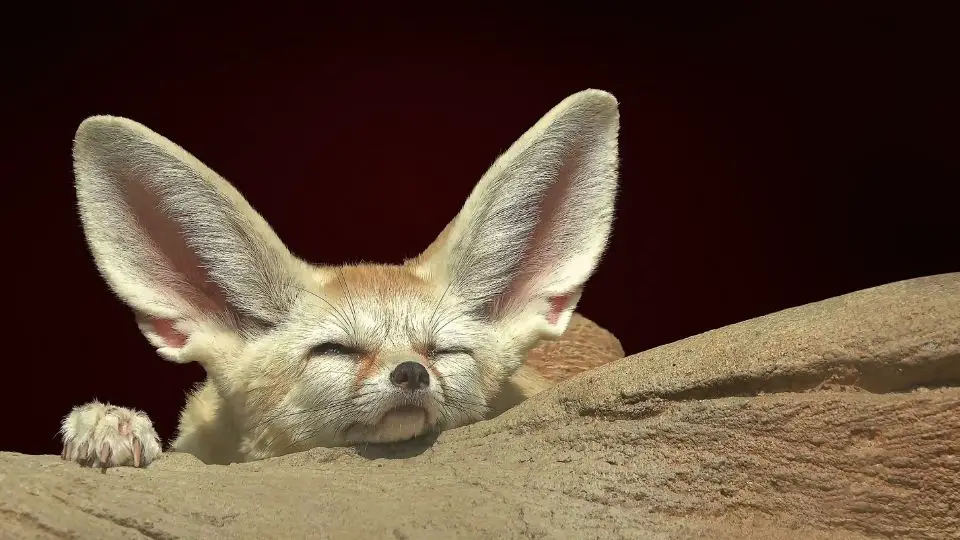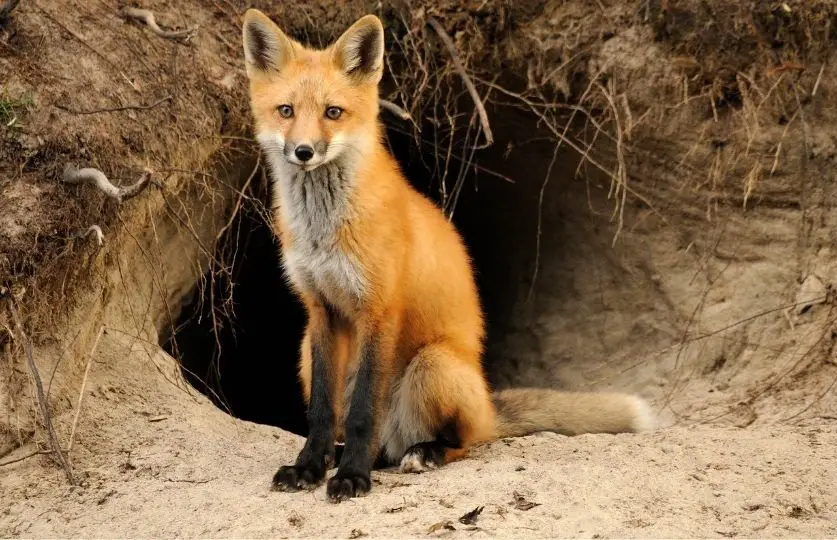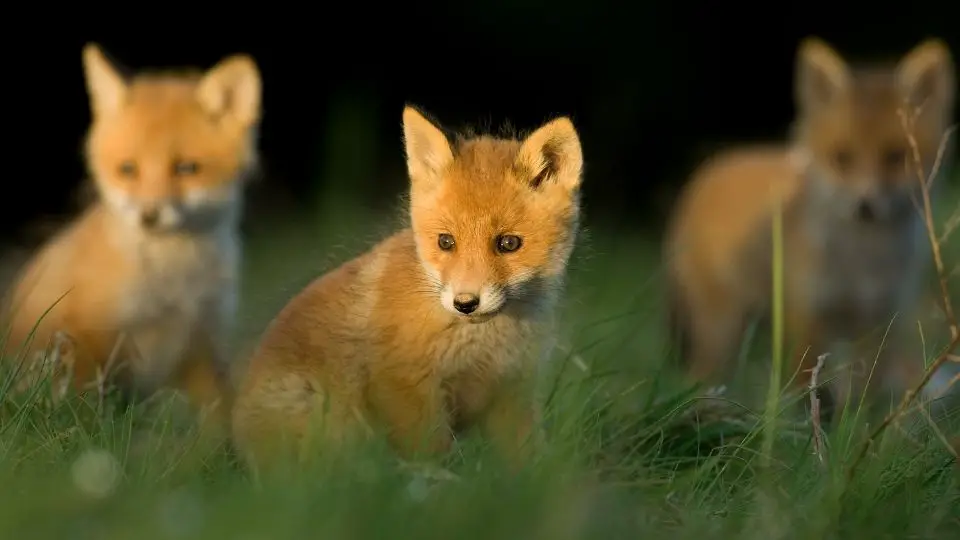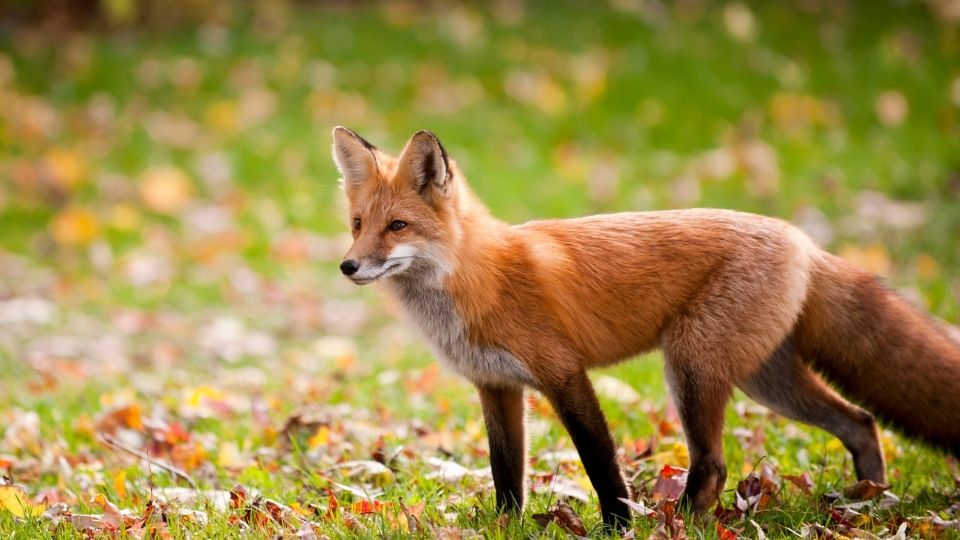Foxes are omnivores and eat mostly meat, as well as fruits and vegetables.
Table of Contents
10 Fox Facts
- Foxes have whiskers on their face and legs, which helps them navigate.
- Foxes can make about forty different sounds.
- Female foxes are called vixens.
- Foxes are part of the Canidae, or canine, family.
- Foxes have such excellent hearing that they can hear creatures moving underground.
- Foxes release unpleasant smells from their scent glands on the upper surface of their tails.
- Fox families are known as “skulk” or “leash of foxes.”
- Foxes in the wild have about a six-year lifespan.
- Foxes have vertical slit pupils, which allow them to see 260 degrees around them and help them with night vision.
- Foxes can retract their claws as cats do.
Types of foxes
There are twelve species of foxes, which are the species that fall under the genus Vulpes. Although each of these species has its own subspecies, there are twelve main types of foxes:
- Arctic fox
- Bengal fox
- Blanford’s fox
- Cape fox
- Corsac fox
- Fennec fox
- Kit fox
- Pale fox
- Red fox, subspecies Black fox
- Ruppell’s fox
- Swift fox
- Tibetan sand fox
Arctic Foxes can be found in North America, Eurasia, Iceland, and Greenland. They have white fur to help them blend in with their snowy surroundings.
Bengal foxes, also known as Indian foxes, live in India, Nepal, and Pakistan. Bengal foxes have a bushy tail with a black tip. They like to build dens underground.
Blanford’s foxes live in mountain ranges in Israel and Afghanistan. They have brown and gray fur.
Cape foxes are found in Africa. These desert foxes are silver and gray with yellow sides.
Corsac foxes live in Asia and China. Some have yellow fur, and others have gray fur.
Fennec foxes, the world’s smallest canine, live in the Sahara Desert and Israel. These foxes are very small but have large ears.
Kit foxes live in the United States and Mexico. Their fur is gray and brown, but they have red and gold fur around their arms and legs.
Pale foxes live in Africa and like to make dens underground. Their fur is a pale tan color.
Red foxes, which usually have red fur, are the most common types of foxes as they are found worldwide. Sometimes red foxes can also be silver, and these variations of the red fox are known as a “cross fox” since the colors are crossed over each other in their fur.
Black foxes are a subspecies of the red fox. These foxes are rare but can be found in North America.
Ruppell’s foxes mostly live in North Africa. These foxes have beige fur and prefer rocky areas.
Swift foxes live in North America. Their fur is light gray, and they are smaller than most foxes.
Tibetan sand foxes live in the Tibetan Plateau. They have orange and tan fur and enjoy being on mountains and cliffs.

Are foxes omnivores?
It is a common belief that foxes are carnivores since they mostly eat meat. However, foxes are actually omnivores because their diet also includes some fruits and vegetables.
Foxes are known for digging through gardens and this is because they will feast on plants and they are searching for fruits, vegetables, and insects. To name a few, foxes enjoy blueberries, blackberries, tomatoes, and potatoes.
What do foxes eat?
Foxes eat a variety of foods. They are good at hunting and catching rodents, rabbits, birds, frogs, snakes, and reptiles. Foxes also enjoy eggs, seeds, and nuts. Foxes will dig to find insects and worms to eat.
Foxes that live near coastal regions will feast on fish and crabs. Foxes also love to eat squirrels. Foxes are excellent climbers, so that they can chase a squirrel up a tree with no problem.
Foxes are scavengers and will eat carrion, or the dead carcass, of almost any wild animal, even if they didn’t kill it. Foxes are such excellent hunters that they will often catch and kill more food than they need, and they will hide and bury it for later.
Foxes in urban areas will dig in trash cans to eat leftover human food.
Wild foxes eat rabbits as one of their primary sources of food. Foxes hunt rabbits that are kept outside as pets. Rabbits provide an easy meal for foxes since rabbits don’t have many defensive features and are small. However, a wild rabbit is fast and may be able to use its speed to escape the hungry fox.
Foxes mostly hunt rabbits in the cold winter months.
Foxes will rarely kill cats to eat them. Foxes prefer to attack small mammals since foxes are shy, skittish creatures. Because of this, foxes are more likely to find an easier meal eating something other than a cat.
If a fox attacks a cat, it is more likely to be a kitten or an old cat. Kittens and old cats can’t defend themselves very well.
For the first two weeks of a baby fox’s life, it will eat the regurgitated food from its mother. Once it gets a little older, the mother will bring it small animals, such as insects and mice, which are still alive, to teach the baby fox how to start killing live animals.

Where do foxes live?
Foxes create dens, also known as burrows, to hide, store food, and care for their babies. Contrary to popular belief, foxes rarely sleep in their dens. Foxes will often have more than just one den. Sometimes foxes will steal dens from other animals that have created one.
A fox’s den often has several entry points for a quick escape. Foxes make large dens to give birth in and store food in. Their dens can be up to about twenty feet deep.
Foxes will create dens out of just about anything. Foxes are known to be pests because they will make homes out of human homes. For example, they may burrow in a pipe, under a house, in an attic, or in a shed.
Foxes also burrow in nature. They may create their home and hiding spot out of a tree, cave, underground, or under logs.
You might be able to spot a fox den by looking for holes, fox tracks, or droppings. Because foxes bring their food to their dens, bones and other animal remains may be found in their dens. Flattened vegetation is another sign that you may have found a fox den.
Foxes create their dens near a water source, so it wouldn’t be uncommon for their den to be near a pond, creek, fountain, or other watery areas. A fox’s den will also be found in a wooded area with plenty of greenery. This prime location will allow foxes to hunt and hide.
Are foxes nocturnal?
While foxes are nocturnal and are mostly active at night, it is not unusual to spot a fox out during the daytime. Sometimes people assume that if they see a fox during the day, it has rabies. This is not necessarily true.

Do foxes come out during the day?
Animals that are diurnal, and active during the day are part of a fox’s diet. So, a fox will sometimes need to hunt during the day. These animals it’s searching for include chipmunks, squirrels, and birds.
Foxes also sleep during the day and will rest while hidden by vegetation. They may sleep in bushes, trees, or tall grass.
Baby foxes: what is a baby fox called?
A baby fox is called a kit or cub, regardless of gender. More than one fox cub, or a group of baby foxes, is referred to as a litter. These terms are shared with other baby animals, too.

